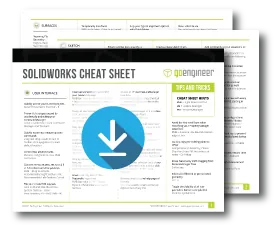SOLIDWORKS STEP Export: AP203 vs AP214
When using SOLIDWORKS, you may need to export your models as STEP files. This is often done when sharing projects with someone running a different version of SOLIDWORKS or when transferring data to another CAD platform. The two main STEP file options available are STEP AP203 and STEP AP214. In this blog, we will look at the differences between the two options.
What is a STEP file?
A STEP file is a standardized, 3D CAD format used for exchanging 3D models across different software platforms, storing product design data such as precise geometry, colors, material properties, and even manufacturing information. Unlike mesh formats like STL, STEP files define solid, editable geometry, making them ideal for mechanical design, collaboration, and process planning, but they are not directly compatible with all 3D printing slicers without conversion.
What is STEP AP203?
STEP AP203 is primarily used for exchanging fundamental 3D model data. It captures the core elements of a design, including geometry and topology, making it well-suited for simple parts and assemblies where extra visual details aren’t required.
Benefits of STEP AP203:
- Core Geometry and Structure: Stores the essential shape and topology of your model.
- Version and Configuration Support: Provides data for handling multiple product versions and configurations.
- Excludes Visual Details: Omits colors, layers, and other non-essential display attributes.

What is STEP AP214?
STEP AP214 expands on the features of AP203 by incorporating support for richer and more detailed data. It’s particularly useful for models that need enhanced visual and dimensional information, making it well-suited for complex assemblies and highly detailed components.
Benefits of STEP AP214:
- Expanded Functionality: Offers all the features available in AP203, with additional enhancements.
- Visual Attributes: Supports elements such as colors and layers to improve design clarity and detail.
- Design Intent Representation: Records the role and purpose of parts within an assembly, improving communication and understanding of the design.

How to Decide Which Format to Use
When choosing between AP203 and AP214, the decision depends on the level of detail your project requires. For simple data exchange focused only on geometry, AP203 is typically sufficient. On the other hand, if your work involves complex assemblies that demand richer visual and dimensional details, AP214 is the more appropriate format.
By recognizing these distinctions, you can export STEP files that align with your project’s needs and ensure seamless collaboration across engineering and manufacturing teams.
Want to learn more? Check out more SOLIDWORKS tips and tricks listed below. Additionally, join the GoEngineer Community to create forum posts, enter design contests, and answer questions from other SOLIDWORKS users.

SOLIDWORKS CAD Cheat Sheet
SHORTCUTS ⋅ MOUSE GESTURES ⋅ HOT KEYS
Our SOLIDWORKS CAD Cheat Sheet, featuring over 90 tips and tricks, will help speed up your process.
Related Articles
Automatic Unit Conversion in SOLIDWORKS File Properties
Exploded Views for SOLIDWORKS Multibody Parts
Faster DWG Conversions Using the SOLIDWORKS 2D to 3D Toolbar
Create Custom Weldment Profiles in SOLIDWORKS

About Zach Brown
Zach Brown is a certified SOLIDWORKS Expert and a Technical Support Engineer. Prior to working at GoEngineer, he spent 15 years as a mechanical designer, CAD support tech, and instructor using SOLIDWORKS. His hobbies include playing guitar, riding motorcycles, and skiing.
Get our wide array of technical resources delivered right to your inbox.
Unsubscribe at any time.